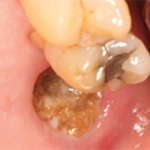While PTH can build new bone and improve bone strength, we do not know the optimal treatment duration or dose. We also do not know if prior use of a bisphosphonate blunts the effect of PTH on bone mass and strength. Over the next few years, expect to see other formulations of PTH; different modes of delivery are currently being tested. A strategy to form new bone with PTH and build up bone strength and then maintain it with a potent anti-resorptive agent may go a long way toward reducing osteoporotic fracture risk.
Glucocorticoid-Induced Osteoporosis
Glucocorticoid-induced osteoporosis (GIOP) is an unfortunate complication of glucocorticoid use. The mechanism by which glucocorticoids increase fracture risk is still under debate. Initially, glucocorticoids appear to increase osteoclast maturation and function, although this is followed by a reduction in osteoblast and osteocyte activity and lifespan. Therefore bone mass, especially trabecular bone mass, is reduced rapidly with glucocorticoid use. In addition, glucocorticoids decrease calcium absorption in the gastrointestinal tract and increase excretion from the kidney, which can create a negative calcium balance and further increase bone remodeling.8 Prevent GIOP through adequate calcium and vitamin D supplements to augment calcium absorption in the gastrointestinal tract. In addition, nearly all bisphophonates prevent and treat glucocorticoid-induced bone loss by inhibiting osteoclast activity.
In vitro and animal studies of GIOP indicate that glucocorticoids reduce mineralization gene expression, and bisphosphonates appear to prevent suppression of mineralization genes by osteocytes and reduce osteocyte apoptosis. In addition to reducing osteoclast-mediated bone remodeling, bisphosphonates may prevent changes in the osteocyte induced by glucocorticoids, helping to maintain bone strength.
One of the main changes in bone metabolism that occur in the presence of glucocorticoids is reduced bone formation. Nearly 10 years ago, studies by our research group found that treating women with postmenopausal osteoporosis and GIOP using PTH could override the glucocorticoid-induced suppression of bone formation and increase bone mass.9 It might be worthwhile to encourage patients treated with glucocorticoids who have osteoporosis to initiate PTH treatment to build up their bone mass and then maintain it with a bisphosphonate.
Inflammatory Bone Loss
As rheumatologists, we frequently see bone loss adjacent to joints that have inflammation. Patients with RA have both bone erosions and reduced bone mass around the erosion. Recently, investigators have shown that a new signaling pathway, the Wnt/b-catenin signaling pathway, which is important in skeletal development and repair, is involved in these bone changes around joints with inflammation. (See “Reading Rheum,” May 2007) The Wnt pathway has agonists that increase signaling through the frizzled receptor, which then transports a protein—b-catenin—into the nucleus to signals bone cells to mature (see Figure 1).

